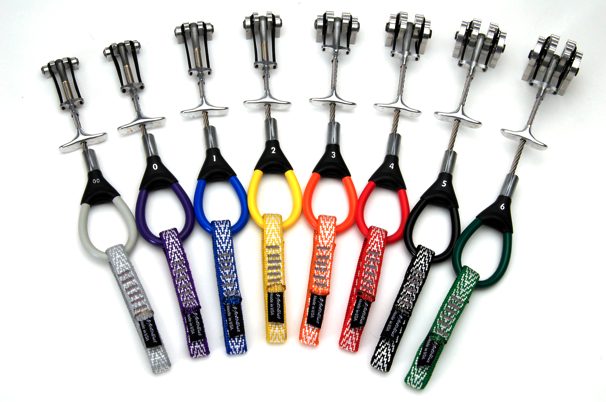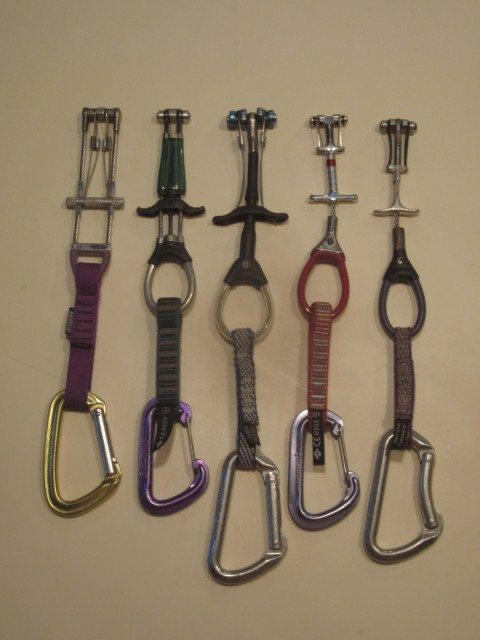Metolius Master Cam

Features:
- 13 mm (0.51″) Monster Sling webbing (36% Dyneema®/64% nylon)
- 13.25-degree cam angle
- Machined cam stops
- Color-coded sewn slings and tubing
- CNC machined
- 7075-T6 aluminum
- 8 sizes
MSRP: $60
Days tested: Several years
Locations tested: Red River Gorge; New River Gorge; Indian Creek; Eldorado Canyon; Rocky Mountain National Park; Grand Teton National Park; South Platte, CO; Index, WA; Enchantments and other alpine routes, WA
Background
When it debuted about five years ago, the Metolius Master Cam was touted as the cam to end the CCH Alien’s reign as the most beloved small cam on the market.
Colorado Custom Hardware has since disappeared, but the end of their patents led to the arrival of multiple clones (or near clones), such as the Fixe Alien and the Totem Basic. The number of devices competing for the small cam niche prompts a revisiting of the “who’s who in small cams” conversation, and no such conversation would be complete without a look at the now-established Master Cam.
I’ve owned a purple size 0 Master Cam for several years now, and I added a black number 5 to the rotation earlier this season. My experience with the rest of the line (mostly the blue, yellow, and orange—my favorite sizes) is from climbing on partners’ racks for the past five years.
Design Elements
First, a quick tour through the nuts and bolts of the device. The Master Cam has four-lobes connected to a molded thumb loop by way of a flexible single stem.
Despite the fact that this was Metolius’ first single stem cam, there are aspects of the Master Cam that will be familiar to climbers accustomed to climbing on TCUs. Chief among these is the cam angle. The Master Cam has the same small (relative to the rest of the market), 13.25-degree cam angle as the TCU.
- Cam Angle
Having devoted space in previous articles to cam angle, I won’t go over this concept in detail here. If you want additional information, check out Blister’s Cams 101 piece. I will say that cam angle is a much more complex thing than Metolius (or any other cam manufacturer), would have you believe.
From a raw mechanics perspective, a smaller cam angle does represent transmission of more outward force, but cams are so robust that you’re talking about padding already massive margins between theoretical forces and the forces experienced in most climbing scenarios.
That said, tighter lobe spirals do affect the way the cam fits into a fidgety placement. I think cam angle is very much a matter of personal preference, and if you’ve never climbed on anything other than Black Diamond cams (which have a relatively large cam angle), I’d recommend borrowing a Master Cam from a friend or picking one or two up in your most-placed sizes before committing to the line.
- Head Width
Back to the tour. The four lobes of the Master Cam sit on a single axle and have a very narrow profile. The head of the black number 5 Master Cam is a slim 3.6cm. Compare this to the 4.2cm head of a size 1.5 Helium Friend or the 4.4cm head of a 0.75 C4. The very recent 0.75 X4 narrowly edges the Master Cam at 3.4cm, but I can’t say I really notice 2mm differences in head width.

At the other end of the scale, the purple zero Master Cam has a 2.6cm profile, compared to the hefty 3.6cm of a size zero Helium Friend, 2.8cm on the 0.1 X4, or 2.4cm on the Black Diamond C3.

For several years now, the C3 has been Black Diamond’s dog in the small cams fight. It’s a three cam unit with exceptionally narrow head width, enclosed trigger wires, and a very compact design. While three cam units are often not as good for small and flaring placements such as pin scars, the C3 works okay since the head is so narrow.
But the Master Cam beats the C3 when it comes to overall performance. For example, the trigger wire enclosure on the C3 might prevent the cables from getting beat up, but it stiffens the stem in a way that I find hinders more than it helps. Point for the Master Cam.
